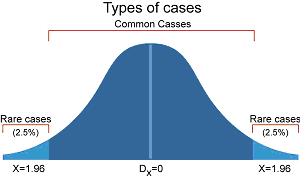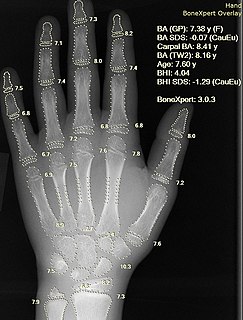How concept processing works
For every physician the bell-shaped curve effect is found, representing a frequency distribution of case types. Some cases are so rare that physicians will have never handled them before. The majority of other cases become repetitive, and are found on top of this bell shape curve.
A concept processor brings forward the closest previous encounter in relation to the one being seen at that moment, putting that case in front of the physician for fine-tuning.
There are only three possibilities of cases : The closest encounter could be identical to the current encounter (not an impossible event). It could be similar to the current note, or it could be a rare new case.

If the closest encounter is identical to your present one, the physician has effectively completed charting. A concept processor will pull through all the related information needed.
If the encounter is similar but not identical, the physician modifies the differences from the closest case using hand-writing recognition, voice recognition, or keyboard. A Concept Processor then memorizes all the changes, so that when the next encounter falls between two similar cases, the editing is cut in half, and then by a quarter for the next case, and then by an eighth....and so on. In fact, the more a Concept Processor is used, the faster and smarter it becomes.
concept processing also can be used for rare cases. These are usually combinations of SOAP note elements, which in themselves are not rare. If the text of each element is saved for a given type of case, there will be elements available to use with other cases, even though the other cases may not be similar overall.
The role of a concept processor is simply to reflect that thinking process accurately in a doctor's own words.
Speech recognition is an interdisciplinary subfield of computer science and computational linguistics that develops methodologies and technologies that enable the recognition and translation of spoken language into text by computers. It is also known as automatic speech recognition (ASR), computer speech recognition or speech to text (STT). It incorporates knowledge and research in the computer science, linguistics and computer engineering fields.

A picture archiving and communication system (PACS) is a medical imaging technology which provides economical storage and convenient access to images from multiple modalities. Electronic images and reports are transmitted digitally via PACS; this eliminates the need to manually file, retrieve, or transport film jackets, the folders used to store and protect X-ray film. The universal format for PACS image storage and transfer is DICOM. Non-image data, such as scanned documents, may be incorporated using consumer industry standard formats like PDF, once encapsulated in DICOM. A PACS consists of four major components: The imaging modalities such as X-ray plain film (PF), computed tomography (CT) and magnetic resonance imaging (MRI), a secured network for the transmission of patient information, workstations for interpreting and reviewing images, and archives for the storage and retrieval of images and reports. Combined with available and emerging web technology, PACS has the ability to deliver timely and efficient access to images, interpretations, and related data. PACS reduces the physical and time barriers associated with traditional film-based image retrieval, distribution, and display.
Digital Imaging and Communications in Medicine (DICOM) is the standard for the communication and management of medical imaging information and related data. DICOM is most commonly used for storing and transmitting medical images enabling the integration of medical imaging devices such as scanners, servers, workstations, printers, network hardware, and picture archiving and communication systems (PACS) from multiple manufacturers. It has been widely adopted by hospitals and is making inroads into smaller applications such as dentists' and doctors' offices.
Medical billing is a payment practice within the United States health system. The process involves a healthcare provider obtaining insurance information from a patient, filing a claim, following up on, and appealing claims with health insurance companies in order to receive payment for services rendered; such as testing, treatments, and procedures. The same process is used for most insurance companies, whether they are private companies or government sponsored programs: Medical coding reports what the diagnosis and treatment were, and prices are applied accordingly. Medical billers are encouraged, but not required by law, to become certified by taking an exam such as the CMRS Exam, RHIA Exam, CPB Exam and others. Certification schools are intended to provide a theoretical grounding for students entering the medical billing field. Some community colleges in the United States offer certificates, or even associate degrees, in the field. Those seeking advancement may be cross-trained in medical coding or transcription or auditing, and may earn a bachelor's or graduate degree in medical information science and technology.

An electronic health record (EHR) is the systematized collection of patient and population electronically stored health information in a digital format. These records can be shared across different health care settings. Records are shared through network-connected, enterprise-wide information systems or other information networks and exchanges. EHRs may include a range of data, including demographics, medical history, medication and allergies, immunization status, laboratory test results, radiology images, vital signs, personal statistics like age and weight, and billing information.
Medical practice management software (PMS) is a category of healthcare software that deals with the day-to-day operations of a medical practice including veterinarians. Such software frequently allows users to capture patient demographics, schedule appointments, maintain lists of insurance payors, perform billing tasks, and generate reports.
A clinical decision support system (CDSS) is a health information technology, provides clinicians, staff, patients, or other individuals with knowledge and person-specific information, intelligently filtered or presented at appropriate times, to enhance health and health care. CDS encompasses a variety of tools to enhance decision-making in the clinical workflow. These tools include computerized alerts and reminders to care providers and patients; clinical guidelines; condition-specific order sets; focused patient data reports and summaries; documentation templates; diagnostic support, and contextually relevant reference information, among other tools. A working definition has been proposed by Robert Hayward of the Centre for Health Evidence: "Clinical decision support systems link health observations with health knowledge to influence health choices by clinicians for improved health care". CDSSs constitute a major topic in artificial intelligence in medicine.
Continuity of Care Record (CCR) is a health record standard specification developed jointly by ASTM International, the Massachusetts Medical Society (MMS), the Healthcare Information and Management Systems Society (HIMSS), the American Academy of Family Physicians (AAFP), the American Academy of Pediatrics (AAP), and other health informatics vendors.
OSCAR McMaster is a web-based electronic medical record (EMR) system initially developed for academic primary care clinics. It has grown into a comprehensive EMR and billing system used by many doctor's offices and private medical clinics in Canada and other parts of the world. The name is derived from where it was created and an acronym; OSCAR stands for Open Source Clinical Application and Resource and McMaster refers to McMaster University, where it was developed. It enables the delivery of evidence resources at the point of care.
Medical transcription, also known as MT, is an allied health profession dealing with the process of transcribing voice-recorded medical reports that are dictated by physicians, nurses and other healthcare practitioners. Medical reports can be voice files, notes taken during a lecture, or other spoken material. These are dictated over the phone or uploaded digitally via the Internet or through smart phone apps.
Voice portals are the voice equivalent of web portals, giving access to information through spoken commands and voice responses. Ideally a voice portal could be an access point for any type of information, services, or transactions found on the Internet. Common uses include movie time listings and stock trading. In telecommunications circles, voice portals may be referred to as interactive voice response (IVR) systems, but this term also includes DTMF services. With the emergence of conversational assistants such as Apple's Siri, Amazon Alexa, Google Assistant, Microsoft Cortana, and Samsung's Bixby, Voice Portals can now be accessed through mobile devices and Far Field voice smart speakers such as the Amazon Echo and Google Home.
A text entry interface or text entry device is an interface that is used to enter text information an electronic device. A commonly used device is a mechanical computer keyboard. Most laptop computers have an integrated mechanical keyboard, and desktop computers are usually operated primarily using a keyboard and mouse. Devices such as smartphones and tablets mean that interfaces such as virtual keyboards and voice recognition are becoming more popular as text entry systems.
Health information technology (HIT) is health technology, particularly information technology, applied to health and health care. It supports health information management across computerized systems and the secure exchange of health information between consumers, providers, payers, and quality monitors. Based on an often-cited 2008 report on a small series of studies conducted at four sites that provide ambulatory care – three U.S. medical centers and one in the Netherlands – the use of electronic health records (EHRs) was viewed as the most promising tool for improving the overall quality, safety and efficiency of the health delivery system. According to a 2006 report by the Agency for Healthcare Research and Quality, in an ideal world, broad and consistent utilization of HIT would:
Clinical point of care (POC) is the point in time when clinicians deliver healthcare products and services to patients at the time of care.
A medical scribe is a person, or paraprofessional, who specializes in charting physician-patient encounters in real time, such as during medical examinations. They also locate information and patients for physicians and complete forms needed for patient care. Depending on which area of practice the scribe works in, the position may also be called clinical scribe, ER scribe or ED scribe, or just scribe. A scribe is trained in health information management and the use of health information technology to support it. A scribe can work on-site or remotely from a HIPAA-secure facility. Medical scribes who work at an off-site location are known as virtual medical scribes.
Digital health, which includes digital care programs, is the convergence of digital technologies with health, healthcare, living, and society to enhance the efficiency of healthcare delivery and to make medicine more personalized and precise. The discipline uses information and communication technologies to facilitate understanding of health problems and challenges faced by people receiving medical treatment and social prescribing more personalised and precise.

The move to electronic medical records (EMRs) is becoming increasingly prevalent in health care delivery systems in the United States.
Voice writing is a method used for court reporting, medical transcription, CART, and closed captioning. Using the voice writing method, a court reporter speaks directly into a stenomask or speech silencer—a hand-held mask containing one or two microphones and voice-dampening materials. As the reporter repeats the testimony into the recorder, the mask prevents the reporter from being heard during testimony.

Artificial intelligence in healthcare is an overarching term used to describe the use of machine-learning algorithms and software, or artificial intelligence (AI), to mimic human cognition in the analysis, presentation, and comprehension of complex medical and health care data. Specifically, AI is the ability of computer algorithms to approximate conclusions based solely on input data.
Federal and state governments, insurance companies and other large medical institutions are heavily promoting the adoption of electronic health records. The US Congress included a formula of both incentives and penalties for EMR/EHR adoption versus continued use of paper records as part of the Health Information Technology for Economic and Clinical Health (HITECH) Act, enacted as part of the, American Recovery and Reinvestment Act of 2009.



